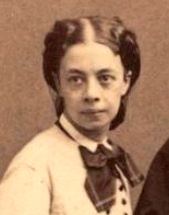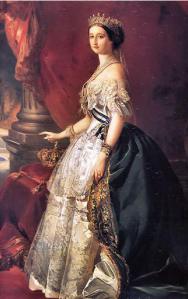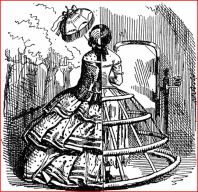From "Victorian Paris" web site
The Fashion Empire of Charles Worth
October 6, 2011 by Iva P.

Charles Frederic Worth 1826–1895
By an anonymous author
When Charles Frederick Worth died in 1895, telegraph carried the news around the world and orbituaries were published in thousands of newspapers. His family received telegrams of condolence from European royalty as well as from clients scattered on every continent. His funeral was attended by two thousand mourners, many of them people of high standing. A king was being laid to rest.
Born in 1825 in Lincolnshire, England, young Charles Worth was destined to become a solicitor like his father and grandfather. However, his father’s drinking and gambling ruined the family finances and when Charles was thirteen, his mother apprenticed him with a printer.
The job was dirty and boring, and a year later, the boy switched to a career in the drapery business. He became an apprentice at Swan and Edgar, drapers in London. To compensate for his lack of education, young Charles read current novels, and when an errand brought him to the vicinity of the new National Gallery, he often went inside. He studied attentively the historical styles of costumes in the paintings. Certain aspects of fashion, he noticed, came round in circles and this knowledge later helped him in refreshing his own designs.
At that time though, he had no other ambition than to succeed in the drapery business. When his seven-year apprenticeship was over, he recognized the need of completing his experience in Paris, the birthplace of fashion trends. In 1846, with no knowledge of the language, and only £5 in his pocket, he arrived in France. After two years of penury and odd jobs, he became a sales assistant at Gagelin, the best of Parisian mercers. He remained there for twelve years, eventually reaching the post of leading salesman in the shawls and mantles department.
Modeling the above articles had fallen to a pretty demoiselle de magasin and it was not long after that Charles Worth and Marie Vernet became an item. To display shawls at their best, Worth designed a few simple dresses for Marie and, soon, the clients became more interested in his creations than in the merchandise on sale. In 1850, he finally talked his employers into establishing a small dressmaking department in the store with a team of seamstresses and himself as the cutter.
The department prospered from the start. With his intimate knowledge of textiles combined with English tailoring techniques, Worth engineered gowns that fitted to perfection while taking into account the characteristics of the material. This was a new approach to dressmaking and Worth’s employers showed their appreciation by including several of his dresses at their exhibit during the Great Exposition in London in 1851. The dresses brought the firm of Gagelin a prize medal. Another medal followed in 1855 at the Exposition Universelle in Paris. Thus exposed to the public, Worth’s work brought an ever increasing number of customers to the Parisian firm.
By now Worth had married Marie, who was to give him two sons: Gaston (born in 1853) and Jean-Philippe (1856). One would think that following his success with dressmaking, his employers would do their best to keep him with the firm. Yet his demand for a partnership was refused and Worth, justifiably angry, teamed up with another disgruntled employee to open a new dressmaking establishment of Worth & Bobergh in rue de la Paix.
The timing was perfect. The net of railways spreading across Europe and the United States, coupled with fast steam ships, brought to Paris and unprecedented number of foreign visitors. Furthermore, the city was now the capital of the Second Empire with all the pomp and display attached to it. With a continuous round of state visits, ambassadorial functions, receptions, balls, and gala performances, the demand for sumptuous dresses escalated vertiginously. Heading the court was Napoléon III’s beautiful wife Eugénie, the arbiter in all matters of fashion.

Princess Metternich - an unlikely, but powerful herald of fashion
To attract attention of such an exalted personage, Worth needed an ally. He aimed at the Princess of Metternich, the wife of a new Austrian Ambassador. Vivacious, although not beautiful, the princess soon found her niche at the court and became a leading fashion-setter. At first, she found the idea of a male milliner utterly ridiculous–at the time, all dressmaking firms were headed by females–but seduced by the album of designs presented by Marie Worth, she finally ordered two dresses. The Empress saw them and Worth was made.

Empress Eugénie, wife of Napoleon III
In 1864, Worth got the monopoly of supplying all evening and state wear for the empress and became the most expensive dressmaker in Paris. Following the empress’s example, other illustrious ladies flocked to his establishment. Worth’s dresses were worn in most Europeans courts but he also dressed the demi-monde. Princess or a highly paid tart, actress, or American millionairess, the Maison Worth was open to all in the spirit of financial democracy.
That a man should see strange women in their underwear, that he should touch their bodies, rankled with the moralists of the era. Enemies were many, but no critique, no moral indignation, could stop Worth’s meteoric rise. Never before had a simple dressmaker consorted with the high and mighty almost as an equal. Before an important ball or masque princesses, duchesses, and countesses came to rue de la Paix for inspection. They paraded before Worth while he decided on last minute changes, on the emplacement of a sash, or the angle of a headdress, and even approved the jewelry. His aim was to create a complete image. His were no longer dresses but “compositions” – too precious to be ruined by a wrong accessory. In an interview, he said:
Those ladies are wisest who leave the choice to us. By so doing they are always better pleased in the end, and the reputation of the house is sustained. Curiously enough, the persons who realize this fact most clearly are precisely those whom you might fancy the most difficult to please. For example, a telegram comes from the Empress of Russia, “Send me a dinner dress!” Nothing more. We are left absolute freedom as to style and material. Not that the Empress is indifferent in the matter of dress. Quite the contrary. She will sometimes require that all the ladies costumes at a certain ball be pink, or red, or blue. And her own dresses are always masterpieces of elegance. The point is that she trusts our judgment rather than her own. In the same way recently we have received over twenty telegrams from Madrid for ball dresses, and we shall make them as we think fit.
To order a dress at Worth’s was a simple procedure. Once the measurements were taken and a dummy made, the client only had to send in a request. With 1200 employees, he turned out hundreds of outfits a week and, if needed, he was able to deliver an elaborate ball gown within 24 hours.
Each time he wanted to launch a new fashion, he recruited his wife and the Princess Metternich. They would go to the races or another notable event wearing the new designs. Such was the prestige of the two women, that no other promotion was necessary.
 The crinoline of the 1850's and 1860's was the greatest fashion aberration with the tight corsets of the 80's and 90's as second runners.
The crinoline of the 1850's and 1860's was the greatest fashion aberration with the tight corsets of the 80's and 90's as second runners.
One of the greatest changes Worth executed was the abolition of the Second Empire crinoline. This absurd cage worn under wide skirts achieved such enormous proportions that the wearers could not function properly. By 1870, the crinoline was gone to be replaced by a bustle. The latter was a padding device attached to the waist. It supported an overskirt drawn to the sides and piled in folds over the bustle. The silhouette was still full but all the bulk was concentrated at the back.
Worth had grown enormously wealthy. He possessed a coat of arms and received guests of high standing in his sumptuous villa at the outskirts of Paris. Neither the events of Franco-Prussian War, nor the fall of the empire and the Commune uprising that devastated Paris had ill effects on his business. The court may be gone, but clients kept coming, keeping him busy to the end of his life. Many other male couturiers followed in his path, but none has achieved the sublime power Worth held over fashion for thirty-five years. He remains the true inventor of the Haute Couture.